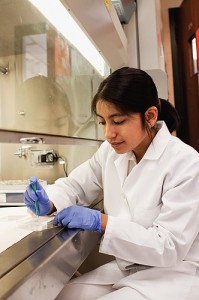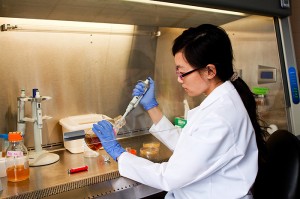UConn undergraduate Leonela Villegas and graduate researcher Jinzi Deng have been working together,

combining their mutual interest in medical research with their chemical engineering backgrounds, to investigate how biofilm growth can result in the development of antibiotic-resistant colonies of bacteria. Leonela, a pre-med junior studying chemical engineering with a minor in molecular and cell biology, and Jinzi, a researcher pursuing her Ph.D. in chemical engineering, are working under the guidance of Leslie Shor, assistant professor of chemical, materials & biomolecular engineering. The duo has been making use of Dr. Shor’s research in microfluidic devices to study the behavior of two bacteria, Pseudomonas aeruginosa and Staphylococcus aureus.
Leonela and Jinzi are studying how the interactions between the two pathogens can lead to greater antibacterial resistance. In co-culture, P. aeruginosa secretes a chemical that is deadly to most S. aureus bacteria, but those that survive, S. aureus Small Colony Variants (SCV), are also more resistant to the antibiotic Tobramycin.
“I’ve always been interested in the symbiotic relationship of these two bacteria. Most of the research on this subject has been more qualitative; my goal since the beginning has been to generate quantitative data from this research. For example, using a microfluidic device, we can relate the measured distance between P. aeruginosa and S. aureus colonies to concentrations and fluxes of chemicals that lead to the antibiotic resistant form, S. aureus SCV,” stated Leonela. “I’ve actually been working on this research for quite some time. Last summer, under Summer Undergraduate Research Funding (SURF) from the Office of Undergraduate Research (OUR), I spent the interim semester here at UConn devoting all my time and energy to this project.”
Cystic Fibrosis Link
Their studies will contribute to many different areas of microbial research related to the growth of biofilms, including understanding more about how these two bacteria may affect cystic fibrosis patients. Cystic fibrosis is a genetic disease that causes the body to produce abnormally thick and sticky mucus, which builds up in the lungs and in the pancreas. Sufferers are troubled by life-threatening lung infections and severe digestion issues. P. aeruginosa and S. aureus are opportunistic pathogens that flourish in the lungs of cystic fibrosis sufferers due to a combination of factors, including a lung environment ideal for bacterial growth.

“The P. aeruginosa and S. aureus bacteria thrive in the lungs of a cystic fibrosis patient; in fact, as the bacterial colonies begin to grow, they create biofilms within the pre-existing mucus,” explained Leonela. “The build-up of mucus in the individual’s lungs makes it difficult for the body’s immune response to be effective.” This co-existence and growth of P. aeruginosa and S. aureus in the diseased respiratory environment ultimately breeds the antibiotic-resistant S. aureus SCV, along with other forms of antibiotic-resistant infections. With declining effectiveness of antibiotics, cystic fibrosis sufferers are plagued by the increasing severity of infection; this scenario is often fatal.
Engineering Insights for Medicine & Biology
In addition to exploring the relationship between biofilm-associated bacteria and their resistance, the young women also seek to understand how microfluidic devices can be used to better test antibiotic concentrations. According to Jinzi, “One of the reasons I became involved in chemical engineering is because I wanted to discover new ways to research the interactions of biofilm-associated bacteria and their micro-environment. It is very useful to apply engineering approaches to medical and biological applications. In medical research, biologists tend to focus on the genetic nature of diseases, while chemical engineers can aid in understanding transport phenomena and kinetics and then apply that to the study of illnesses at a microbial level. The use of microfluidic devices to analyze the behavior of biofilms is one way of approaching this research.”
Jinzi first became passionate about applying her engineering background to medical research while working at the University of Luebeck’s Institute of Biochemistry in Germany. She conducted research under the supervision of Dr. Rolf Hilgenfeld, a world-renowned researcher recognized as the first person to identify a weakness in the SARS (Severe Acute Respiratory Syndrome) virus. An extremely serious form of pneumonia, SARS caused a scare in 2003 when more than 8,400 individuals became infected rapidly around the world, resulting in the deaths of over 900 people. “Working with Dr. Hilgenfeld reinforced within me that I wanted to pursue a career in disease-related research; I felt as though this was a way for me to contribute to the greater good.”
At present, Leonela and Jinzi are using oxygen sensing films to measure the cellular activity of the pathogens. The films exude a bright red fluorescence as oxygen is used up by the P. aeruginosa and S. aureus. As the cells die and cease to absorb oxygen, the film gradually darkens to black. “Right now, we are subjecting the cells to concentrations of formalin to establish a foundation on how the oxygen sensing film responds to changes in bacterial respiration. We will then begin to experiment with antibiotics and can reference our formalin ‘control’ data,” said Leonela.
Both Leonela and Jinzi plan careers in medical or biomedical areas. Leonela will pursue a degree in medicine to practice as a pediatrician or a pulmonologist. Jinzi, who received bachelor’s degrees in chemical and environmental engineering in China and Germany, respectively, plans to stay involved in bacterial antibiotic resistance research after completing her doctorate.


